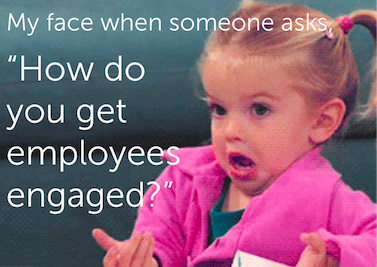What do you think when you hear the term “employee engagement”? As a broker, you likelystart thinking of your clients’ needs to ensure employees areaware and engaged with their benefits plan. A more traditionaluse of the term may refer to employee commitment levels toward thecompany purpose and vision. Both are accurate, and the twopoints are definitely connected.
|Quantum Workplace (the research firm behind the "Best Places toWork" programs in more than 40 metro areas) identifies severalkey factors of companies with higher engagement levels. One ofthem is:
|“Provide employee benefits that demonstrate a strongcommitment to employee well-being.”
|Because successful implementation doesn’t come from simplyproviding the benefits, I’m sharing three tips from HR managers who’ve had successful employeeengagement with non-insurance services.
|1. Communication is key
When I was an HR Director, making sure my employees used andunderstood their benefits was my holy grail. If they didn’tuse the ones we paid for, I wondered:
Do they understand the benefits?
Do they care?
Is it just too much information?
If open enrollment is the primary time employeeshear about their benefits, any of the above could be an issuecausing low engagement. It isn’t enough to present the informationonce a year. It’s important to talk about it, talk about it,and finally, talk about it!
| Including a personal story during employeeonboarding is a memorable way to share the positive impact ofspecific benefits. This strategy should be used not only by HR, buteveryone in a management position. For example, train managersto ask employees who call in sick if they’ve used theirtelehealth service. It’s a quick and easy wayto remind them of the benefit while showing genuine concern.Suggest something as simple as, “Have you called the telehealthdoctor yet? Please do so. Remember, it doesn’t cost youanything. I used it last time I was sick and they helped mefeel better much faster.”
Including a personal story during employeeonboarding is a memorable way to share the positive impact ofspecific benefits. This strategy should be used not only by HR, buteveryone in a management position. For example, train managersto ask employees who call in sick if they’ve used theirtelehealth service. It’s a quick and easy wayto remind them of the benefit while showing genuine concern.Suggest something as simple as, “Have you called the telehealthdoctor yet? Please do so. Remember, it doesn’t cost youanything. I used it last time I was sick and they helped mefeel better much faster.”
If an employee is dealing with a family member’s illness, remindmanagers to suggest an advocacy or doctors online service to gethelp with second opinions or other advice. HR staff are thebiggest influencers for advocacy services. HR so often takesthe brunt of complaints and questions as employees try to usetheir benefits and get confused or frustrated with the complexitiesand costs of the system. Instead of trying to solve all ofthem, Calli Corley, HR Director of The DeltaCompanies explains, “Advocacy saves me a lot oftime — I no longer have employees bring me a stack ofEOBs to look over and tell them what to pay!”
|Throughout the year at various staff meetings, invite topexecutives or other champions to talk about their experienceswith various services. Employees will both connect to and rememberthe stories, which drives awareness, appreciation andutilization.
|2. Know your audience
Part of any great communication plan is knowing your audience.Consider who will be in various meetings. For example, if youhave a primarily Spanish-speaking workforce, make sure youutilize your resources in Spanish and provide a translator inyour meetings.
|One commonly overlooked area is generational preferences.Different ages prefer varying methods of activities for bothregistration and use of services. Prepare your presentationaccordingly. Multiple options such as phone, website, or appwill provide familiar and easy-to- use choices for everyone.
|All generations appreciate honesty andpersonalization. Many top-performing companies provide anannual (or quarterly) Total Compensation Statement to each employeeshowing their benefits and compensation totals. Make it easy to seewhat the company and the employee each pay for. This helps with the‘out of sight, out of mind’ aspect to benefits. Explaining theseitems with complete transparency is a win for everyone.
|3. Include custom choices
The ability to customize some benefit selections is appreciatedby employees and allows the employer to meet the needs of adiverse workforce. For example, one employee will highly valuepet care benefits, while another has no use for them at all.Identity theft protection, legal savings, auto and homediscounts — each of these appeal to some and not toothers.
|A recent article cited MetLife’s 13th Annual U.S. EmployeeBenefit Trends Study found that 40 percent of employees sayhaving a wide selection of benefits would make them feel more loyal to their employer. Employeeswill definitely engage in benefits they’ve customized to meet theirspecific needs. Increasingly, the “cool” customized benefitsare stronger differentiators for employers than the
health plan.
Understanding a group’s needs, their usage of differentproducts and how the solutions you offer deliverresults — these all make you a valued consultant who’sreally looking out for their best interests. Offeringthese engagement tips to stress the importance of using theirnon-insurance services ensures you remain the broker they wantto come back to time and time again.
|Now it’s your turn! What tips do you share with clients forsuccessful employee engagement? Comment below or email me [email protected].
Complete your profile to continue reading and get FREE access to BenefitsPRO, part of your ALM digital membership.
Your access to unlimited BenefitsPRO content isn’t changing.
Once you are an ALM digital member, you’ll receive:
- Critical BenefitsPRO information including cutting edge post-reform success strategies, access to educational webcasts and videos, resources from industry leaders, and informative Newsletters.
- Exclusive discounts on ALM, BenefitsPRO magazine and BenefitsPRO.com events
- Access to other award-winning ALM websites including ThinkAdvisor.com and Law.com
Already have an account? Sign In
© 2024 ALM Global, LLC, All Rights Reserved. Request academic re-use from www.copyright.com. All other uses, submit a request to [email protected]. For more information visit Asset & Logo Licensing.








